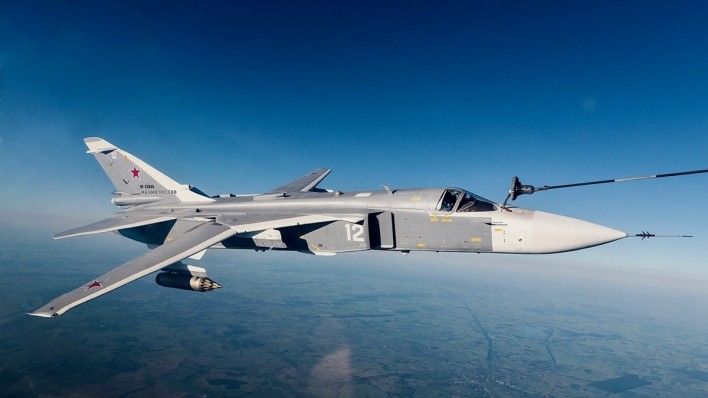Russian Response to Defence24.pl Article: What is Truth about the Russian Military Aviation? [Commentary]

The Russian media have made a reference to our article outlining the quantitative shape of Russian military aviation. The quantity has been placed against the background of the manufacturing capacity of the Russian Aviation Industry. The article was criticized by General Vladimir Popov, interviewed by PolitRussia. The present article discusses the remarks made by General Popov.
Link to the Russian article, featuring General Popov’s statements, can be found below:
The article entitled “Intelligence Failure: Military Pilot Popov Criticizes the Poles’ Discussion of Russian Aviation”, makes a claim suggesting that the Polish article shows insufficient comprehension skill on the part of the Polish author, when it comes to the processes happening in the Russian aerospace industry, along with wishful thinking and national complexes. Another theory mentions the Polish press’s willingness to win over the hearts of the “West”.
General Popov stated that, when it comes to the generational leap in the case of the military equipment, the Russians have left this problem behind themselves 10 years ago, while the Russian Armed Forces' equipment is modern, to a degree exceeding 70%. Leaving the methodologies aside, we need to point out that our article did not refer to the whole inventory of the Russian Armed Forces. The article discussed the Russian combat and support aviation, without mentioning the rotary-winged assets.
The aforesaid component of the Russian Air Force is in a state described within our piece. Many of ca. 1,600 aircraft are more than 30 years old, the lifecycle extension cannot go into infinity, while the Russian combat aircraft manufacturing capacity would not be enough to fill in the gap. This has been discussed in detail in our previous article.
This means that a reduction in the quantity of Russian aircraft would be unavoidable. Paradoxically, the last decade is the best proof of the upcoming decline. Russia indeed has introduced numerous platforms in high quantities.
From the beginning of 2011 - at least 403 aircraft: 98 Su-35s, 130 Su-30s, 20 Su-27SMs, 16 MiG-29SMTs + naval jets, 6 MiG-35s, 130 Su-34s, 2 T-160s and 1 Su-57s (plus 104 Yak-130 trainers). These numbers are impressive, but they are not impressive when compared to the current figures referring to the manufacturing of the F-35 - with more than 130 being rolled off the production line per year, as opposed to the Russian manufacturing capacity - 40 combat aircraft per year. This volume would not make it possible to maintain 1,600 combat aircraft in service. This is more pronounced, given the fact that some of those aircraft were simply upgraded and reintroduced.
The only way to save the quantitative shape of the Russian Air Force is to boost the manufacturing of aircraft during the current decade, in comparison to the preceding one. Nothing suggests that this could happen. Furthermore, the peak in deliveries happened in 2014 - then, a major decrease occurred, especially following the year 2015.
The Soviet technology was of high class (but worse than the US counterparts of its era). However, the USSR fell in 1991. Based on the inheritance and legacy of the USSR, the Russian industry did manage to create further, satisfying platforms, based on the Su-27, including aircraft such as Su-30, Su-34, or Su-35. The modernization potential of this family of platforms has been depleted, and the latest variant of the Su-35 is the final iteration of the Flanker family. Its performance is disputable. The recent reports suggest that the Egyptian Air Force conducted test engagements between Su-35 and Rafale, with the French design being superior. This was reported first by the Russian media outlets.
In early 2020, Chinese Colonel Li Chunghua Hu’s lecture at the Northwestern Polytechnical University. He was discussing the results of engagements between the Chinese Su-27s and Thai JAS-39 C/D Gripens. It turned out that the Gripens were superior in a fight against the heavy air superiority aircraft.
Meanwhile, the development of new designs entails major costs and risks. These apply to the F-35, mentioned in the Russian critical piece, but the Su-57's situation is even worse. One can only make wild guesses, as to how many of these aircraft would be manufactured by the end of this decade. The number mentioned is 78, with the deadline set in 2028. Many signs suggest that no positive outcome can be expected here. India resigned from the FGFA programme, derived from the Su-57. The Indian Air Force is rather inclined to launch the AMCA programme of their own or engage in cooperation with the West. During the IDEX-2021 event, none of the Arab nations expressed interest in the export variant of the Su-57, the Su-57E. Meanwhile, the only nation authorized to procure the F-35 - the UAE - declared an immediate procurement.
The argument suggesting that legacy Soviet aircraft remain in service all around the world seems to be ungrounded here. The MiG-21 is still being maintained for instance - but this is because no money is available to replace it. Its combat worthiness is disputable. The pilots refer to it as the "flying coffin". Keeping these flyable does not mean that the aircraft in question would have any value in a future conflict.
In the case of the Su-17/22, the situation is similar. They reach the ends of their lifetimes. The Fitters in Poland are kept in service only to maintain the operations at the airbase, and to keep the personnel active until the replacement arrives - in a form of the F-35A.
General Popov claims that Lightning II is not a successful design. He stated that this is proven by the fact that the Americans are willing to replace it with a 6th generation platform. However, one should note that the US NGAD (Next Generation Air Dominance) programme is aimed at creating an air-superiority platform that would replace the F-15 and F-22 - the new aircraft is to be capable of operating in an A2AD environment and provide total superiority over the Chinese J-20, and J-31, and the Su-57 - once the aforesaid aircraft become operational. The F-35 is a multi-role workhorse - and this is how the jet is perceived at the Pentagon, during any war games.
Furthermore, the F-35 is being continuously procured - not only in the US, as any nation that can afford the jet, and able to procure it from the US, eyes the F-35 acquisition. These acquisitions show that investment in brand new 4/4+ platforms starts to be viewed as unreasonable. The fourth-generation jets will play a less important role in a future conflict. Not only did the nations acquiring the F-35, such as Japan or Poland, conclude as such, as the PRC also seems to understand this, investing in the J-20 platform and pursuing the multi-role J-31 program.
If the above is true, and the 5th generation aircraft turn out to be the Dreadnought of the era (a new generation warship that, back in 1906, established a ground zero among the navies), Russia may find itself in dire straits. Currently, the Russian Aerospace Forces operate a single type of similar capabilities. If all goes according to Plan, Moscow will have 100-120 aircraft as such, by the end of the decade.
